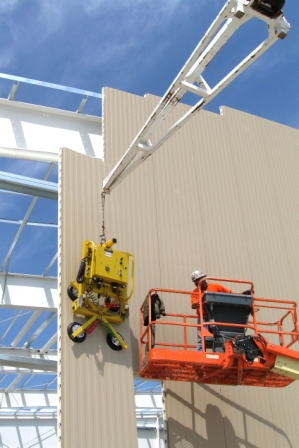
Vacuum lifters are being utilized more and more for lifting and handling insulated metal panels
There are several factors to consider before choosing an end effector for lifting and maneuvering construction materials. Wire rope slings, lifting clamps and vacuum lifters are all useful pieces of equipment that can be utilized with booms, cranes and lift trucks. The most significant contribution end effectors provide is the ability to reduce operator strain while manipulating heavy or awkward loads. Not only do they ease the burden, they provide added benefits in the form of increased safety, efficiency and productivity.
Unfortunately, there is no one-size-fits-all for all handling situations. Safety should always be the first priority when choosing the proper equipment needed on the job site. Whether working at height or ground level, handling insulated metal panels, glass or sheet metal can be dangerous. Equipment and material clearance requirements during attachment and load manipulation are vital elements to prevent injury to the operator or others on the job.
 |
Vacuum lifters are capable of handling long loads that need adequate support across the load surface to prevent deformation or breakage during the lift. site. Insulated metal panels for roof or wall applications are available in a variety of widths, lengths, profiles, gauges and finishes, all of which present particular handling challenges. Vacuum lifters are being utilized more and more for lifting and handling insulated metal panels, especially when installing panels in tight spaces, such as under roof overhangs, or panels that extend from floor to ceiling, leaving little space for a hook, sling or strap.
Unlike traditional lifting tackle, vacuum lifters attach to the front of the panel leaving the edges clear to slip easily into place during installation. Since vacuum lifters have the ability to rotate and tilt the panel while in the air, positioning the panel for installation is safer and easier. Vacuum lifters are capable of handling long loads that need adequate support across the load surface to prevent deformation or breakage during the lift.
Different surface profiles and finishes also require special consideration to avoid accidental load release or cosmetic damage to the load during the lift. Vacuum pads on the lifter feature a soft suction seal that doesn’t shift on the panel, helping to avoid surface and finish damage. When choosing end effectors to work with your lifting equipment and the material being handled, consider the following important factors:
• Assess the nature of the work the end effector will be required to perform.
• List the features and functions needed in relation to material size and weight.
• Analyze the lifting equipment in terms of clearance, height and capacity.
• Determine the mode of attaching the end effector to the lifting equipment.
• Define the load manipulation required to perform the job. Does the load need to tilt, rotate or both? Do you need to unload the materials from a truck or crate?
• Research power requirements and the corresponding specifications of the end effector.
• Consider alternative and future applications for which the end effector can be used.
No matter what end effector you choose to use with your lifting equipment, stay safe and always observe industry best practices.
Wood’s Power-Grip Co. Inc. engineering team, Laurel, Mont. For more information, visit www.powrgrip.com.






